While COMESA’s work on conflict prevention is anchored on Article 3(d), “to cooperate in the promotion of peace, security and stability among Member States in order to enhance economic development in the region” that work cannot be complete without essential documentation. Documentation and Information is one of the important processes as articulated in Article 118 of the COMESA Treaty. More specifically, documentation is important for capacity building as stakeholders benefit from the wide range of experience captured in documentation. Documentation also ensures standardisation and sustainability of conflict prevention efforts. As part of the Governance, Peace and Security programme, COMWARN since its onset has been documenting its activities in the form of reports and several publications. Among some of the documents developed include the Rules of Procedure for the COMESA Committee of Elders, the Rules for Accreditation of CSOs and the COMWARN SVA Primer (2011). Concerted efforts continued in 2019 leading to the development of additional manuals on various areas of implementation. These included the following:
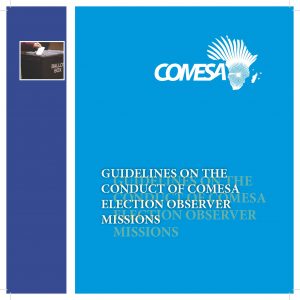
Guidelines on the Conduct of COMESA Election Observer Missions |
The Guidelines on the Conduct of COMESA Election Observer Missions provide a framework used by COMESA to guide the observation of elections upon invitation by Member States. The development of the Guidelines was necessitated by the need to develop a standardized framework to support regular and periodic elections in Member States which are an expression of people’s sovereignty from which the authority and legitimacy of government is drawn. This support would also enhance peace and stability in Member States. The guidelines have been developed in line with the international and regional regimes that guide the conduct of elections. These go as far as the Universal Declaration of Human Rights, the International Covenant for Civil and Political Rights and the African Charter on Democracy, Elections and Governance, among others. Furthermore, COMESA Election Observer Missions are also guided by the national legal regimes that guide the conduct of elections. | |
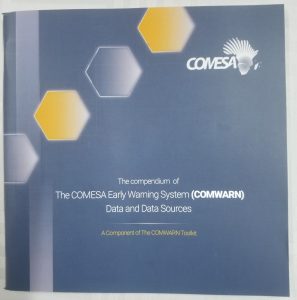
The COMWARN Structural Vulnerability Assessment (SVA) Primer |
The Primer introduces SVAs as well as provides an overview of the Africa Prospects software tool as developed by the African Union to assess structural vulnerabilities of countries. It provides the key features of the African Prospects. The Primer further highlights the customization of the Africa Prospects by COMESA to undertake SVAs for a composite target, the COMESA Peace and Prosperity Index (CPPI). The bulk of the Primer is a detailed ten-step process of conducting COMWARN SVAs, including the specification of the Target Variable, the selection of the Explanatory Variables, the compilation of indicator data sets, building and running the model, comparing results, collating results from the forecasted levels of CPPI, the identification of country-specific indicators and their associated levels of CPPI, evaluation of the forecasts, and the formulation of actionable recommendations to mitigate structural vulnerabilities. | |
 The Compendium of COMWARN Data and Data Sources The Compendium of COMWARN Data and Data Sources |
This is a compilation of the global data sources as used by the COMWARN model. It details the twelve data sources including a description of the indicators derived from these sources. It provides such information as the name of the indicator as used by the developer and the name as used by COMWARN, and the basket in which the indicator fits. A brief description is given on the data source, the methods used to develop the indicator, the relevance of the indicators to peace and prosperity and any limitations of the indicator with respect to its usage to support the analysis. Out of the twelve data sources, COMWARN gets 97 of its 144 indicators from three data sources, the World Bank (64), the World Economic Forum (16) and the Mo-Ibrahim Foundation (14). Therefore, the description of indicators from these sources is less detailed than the indicators sourced from the other nine sources. The document is supported by two annexes, the first contains the “Candidate Indicators” for COMWARN that were adopted by the 11th Meeting of the COMESA meeting of the Ministers of Foreign Affairs that was held in Lilongwe in October 2011. This followed the identification of common structural factors that affect COMESA peace and prosperity. The second annex provides a listing of all 144 indicators with a brief description of each. | |
| The Manual for Conflict analysis and report writing | The manual is developed for use by any practitioners in the field of conflict prevention and peace building including students of peace studies. In addition, any person involved in developing early warning reports, mediation or mediation-related roles needs to have a good understanding of conflicts and their dynamics. The Manual is a practical tool and reference guide which recognizes that conflict analysis is both a critical and complex endeavour that requires a systematic approach. Conflict analysis is a science which can be enhanced and strengthened through education and continuous exposure to the various methodologies, approaches and tools. This Training Manual captures the multi-dimensionality of conflict by emphasizing the importance of a holistic approach which seeks to understand the political, social, economic, security and environmental drivers of peace and security. Comprising of eight chapters, this Training Manual starts with an overview of key concepts, including conflict, peace and security. The manual then zeroes in to focus on unpacking the concept of conflict analysis and provides an outline of the principles of conflict analysis, as well as a detailed examination of the COMESA Conflict Analysis Framework. | |
| The SVA Training of Trainers’ Manual | The Training Manual acknowledges the efforts towards supporting capacity in fully understanding the drivers of peace and conflict, and therefore builds on the COMESA COMWARN Structural Vulnerability Assessment (SVA) methodology, which is anchored on the COMESA Peace and Prosperity Index (CPPI). The development of the Training Manual was based on the need for stakeholders in Member States to fully understand the COMWARN SVA model and be able to train other stakeholders on the SVA methodology using this manual as a guide. | |
| The Handbook on the mediation of electoral-based conflicts | This Handbook seeks to assist mediators working on electoral-based conflicts including the COMESA Committee of Elders and other mediators/stakeholders to mitigate and resolve electoral-based conflicts in the region. The design of this Handbook was based on the premise that the mediation of electoral-based conflicts is unique and differs somewhat from the mediation of other conflicts. To this end, peace mediators should be aware of this if they are to deal adequately with electoral-based conflicts, they need to acknowledge their specific nuances and complexity. | |
| The Handbook on the mediation of natural resource-based conflicts | This Handbook seeks to assist mediators working on natural resource conflicts including the COMESA Committee of Elders and other mediators/stakeholders to mitigate and resolve resource-based conflicts in the region. The design of this Handbook was based on the premise that the mediation of natural resource conflicts is unique and differs somewhat from the mediation of other conflicts. To this end, peace mediators should be aware of this if they are to deal adequately with natural resource conflicts, they need to acknowledge their specific nuances and complexity. | |
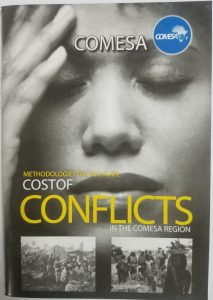
|
This manual contains the findings from a research that was conducted by COMESA to develop methodologies for assessing the costs of conflicts. The undertaking was in response to a Decision by the Fifth Meeting of the COMESA Ministers of Foreign Affairs, which was held Kampala, Uganda in June 2004. The Decision specifically identified the need for COMESA to undertake a quantification study to assess the cost of conflicts in the region, with particular emphasis on the less obvious indirect costs. It was also found important that such an assessment would have to be done within a regional framework in order to ensure that certain regional factors that are not always easy to identify were also captured. The research was conducted in three phases that included the identification and evaluation of costing methods, field research and validation. The undertaking was supported by the International Development Research Center (IDRC) and the University for Peace – Africa (UPEACE – Africa).
|
|
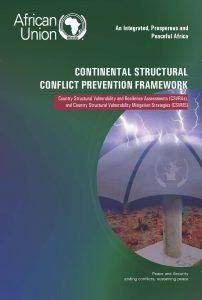
|
The African Union (AU) has adopted several normative instruments to facilitate the structural prevention of conflicts. These instruments relate to human rights; governance and the fight against corruption; democratisation processes; disarmament; terrorism; and the prevention and reduction of interstate conflicts. They collectively represent a consolidated framework of commonly accepted norms and principles, whose observance would significantly reduce the risk of conflict and violence and consolidate peace where it has been achieved. Drawing from these Instruments, and more specifically the African Union Constitutive Act (OAU 2000), the Protocol Relating to the Establishment of the Peace and Security Council (African Union 2002), as well as the recent decisions and communiqués by the Peace and Security Council (PSC), committing itself to a comprehensive conflict prevention, management and resolution, the African Union Commission has developed various tools designed to facilitate the structural prevention of conflicts in Africa. The AU’s Continental Structural Conflict Prevention Framework (CSCPF) has been developed to facilitate a Commission-wide coordinated approach to structural conflict prevention. It seeks to identify and address structural weaknesses which often evolve overtime, with a potential to cause violent conflicts if they remain unaddressed. The CSCPF defines preventive action as involving both a direct and operational focus of intervening before large-scale violence occurs as well as a structural, strategic focus of addressing the structural causes of conflict.The design of the CSCPF responds to the following needs:(i) hastening the implementation of the African Peace and Security Architecture (APSA); (ii) strengthening the coordination and harmonization role of the AU vis-à-vis the the Regional Economic Communities (RECs), as stipulated in the PSC Protocol; (iii) mainstreaming conflict prevention into the activities and programs of the Commission; and (iv) addressing the structural or root causes of conflict in Africa more systematically. |
|
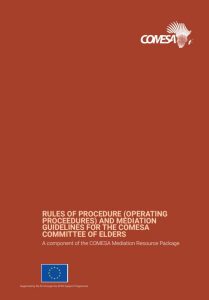
|
The document is for use by the COMESA Committee of Elders as well as COMESA Secretariat. It includes the Rules of Procedure to guide the operations of the COMESA Committee of Elders. The Rules of Procedures are supported by two annexes, the first is a set of mediation guidelines and the second are Rules of Procedure for the nomination and elections of the Committee of Elders. It serves as a good reference document for the Elders that are deployed to support COMESA Missions. The Rules of Nomination and Election are useful to the Member States in their processes of nomination of eminent persons to join the Committee and in the elections process that is typically done by the COMESA Ministers of Foreign Affairs. The Rules were initially developed by the COMESA Committee of Elders, reviewed by the COMESA Committee on Peace and Security and Ministers of Foreign Affairs before going through the COMESA Sub-Committee of Legal Affairs. The Rules were adopted by the Ministers of Justice and Attorneys General on 6th November 2013. |
Quick Contact
Need Help?
Please Feel Free to Contact Us. We Will Get Back to you within 1-2 Business Days.
info@comesa.int
+260 211 229 725/32
